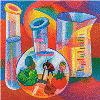Chemical and Biomolecular Engineering, Department of: Papers in Subdisciplines

Papers in Biotechnology
Date of this Version
October 2000
Abstract
An unstructured growth model for the recombinant methylotrophic yeast P. pastoris Mut+ expressing the heavy-chain fragment C of botulinum neurotoxin serotype A [BoNT/A(Hc)], was successfully established in quasi-steady state fed-batch fermentations with varying cell densities. The model describes the relationships between specific growth rate and methanol concentration, and the relationships between specific methanol and ammonium consump-tion rates and specific growth rate under methanol-limited growth conditions. The maximum specific growth rate (μ) determined from the model was 0.08 h−1 at a methanol concentration of 3.65 g/L, while the actual maximum μ was 0.0709 h−1. The maximum specific methanol consumption rate was 0.0682 g/g WCW/h. From the model, growth can be defined as either methanol-limited or metha-nol-inhibited and is delineated at a methanol concentration of 3.65 g/L. Under inhibited conditions, the observed biomass yield (YX/MeOH) was lower and the maintenance coefficient (mMeOH) was higher than compared to limited methanol conditions. The YX/MeOH decreased and mMeOH increased with increasing methanol concen-tration under methanolinhibited conditions. BoNT/A(Hc) content in cells (a) under inhibited growth was lower than that under limited growth, and decreased with increasing methanol concentration. A maximum a of 1.72 mg/g WCW was achieved at a μ of 0.0267 h−1 and induction time of 12 h.


Comments
Originally Published in, BIOTECHNOLOGY AND BIOENGINEERING, VOL. 70, NO. 1, OCTOBER,2000;John Wiley & Sons, Inc. This article can be better viewed at the publishers site: http://www3.interscience.wiley.com/cgi-bin/fulltext/72514259/PDFSTART DOI: 10.1002/1097-0290(20001005)70:1<1::AID-BIT1>3.0.CO;2-Y